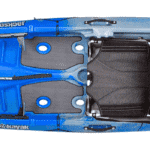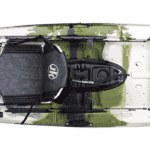So you’ve got your kayak and a bag of gear waiting to get out on the water. Awesome, now let's find a solution for transporting it.
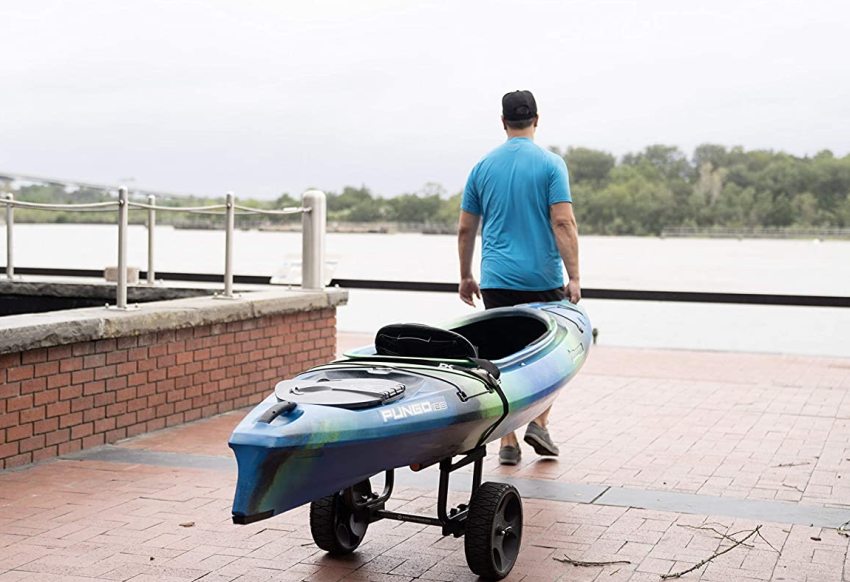
Transporting your kayak is a multi-tool kind of job. It takes a kayak roof rack or kayak trailer to transport your vessel to the lake, river, or beach where you’re going to paddle, but you’ve still got to get the kayak from your car to the water.
You might be thinking, “Well, I can just carry my kayak. That should work fine, right?”
Yes and no.
If you can park close to the water and your kayak is light, then yes, you could probably man-handle it from the car directly to the shore.
But what if the kayak is heavy and loaded with fishing gear? What if the terrain between your car and the shore is rough or uneven? What if you have to walk down a trail to get from the parking lot to the water while also carrying your paddle and wearing your PFD?
That’s where you might need a kayak cart to help you do the heavy lifting!
Below, we’re going to take a deep dive into the absolute best kayak carts on the market, giving you all the top-notch options you need to make the kayak-hauling process a breeze.
We’ll teach you about the different types of kayak carts, the important features to consider, and, of course, which one suits your needs best.
Get ready to find the perfect addition to your kayak-transporting toolkit!
As an affiliate of Amazon and other retailers, we may earn a small commission when you buy via our links, at no additional cost to you. Thank you!
A Quick Peek at Our Top Kayak Cart
Don’t have time to read the whole article? Don’t sweat it! Here’s why we chose the RAILBLAZA Ctug Kayak Cart as the best kayak cart for you:
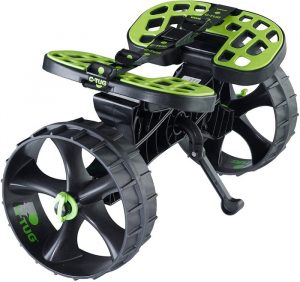
- Adjustable rubberized pads compatible with most kayak hulls
- No-puncture rubber-tread tires
- Up to 300-pound weight capacity
- Durable and solidly built
- Easy to dismantle and store
- Resistant to rust and water damage
At a Glance: Best Kayak Carts
- Best Overall: RAILBLAZA Ctug Kayak Cart
- Best Weight Capacity: Wilderness Systems Heavy Duty Kayak Cart
- Best Lightweight: Suspenz Smart Airless DLX Cart
- Most Compatible: Malone Clipper Deluxe Universal Kayak Cart (fits with the broadest range of kayaks/canoes)
- Best Compact: ABN Universal Kayak Carrier
- Easiest to Store: Bonnlo Kayak Cart Canoe Carrier Trolley
- Best for Rough Terrain: Wilderness Systems Heavy Duty Kayak Cart (navigating sand dunes or lots of forest)
- Best for Sit-On-Top Kayaks: Bonnlo Scupper Kayak Cart
- Best Budget Cart: TMS Kayak Carrier Trolley
Comparison Table: Best Kayak Carts, Wheels, and Trolleys
| Model | Specs | Where to Buy |
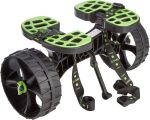 RAILBLAZA Ctug Kayak Cart | Type: Platform Size: 6 x 10 x 30″ Weight: 9.6 lbs. Capacity: 300 lbs. | Amazon |
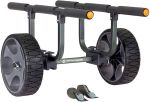 Wilderness Systems Heavy Duty Kayak Cart | Type: Platform cart Size: 33 x 12 x 6.75″ Weight: 13 lbs. Capacity: 450 lbs. | Amazon |
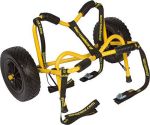 Suspenz Smart Airless DLX Cart | Type: Tail-dragger Size: 13 x 18″ Weight: 9 lbs. Capacity: 125 lbs. | Amazon |
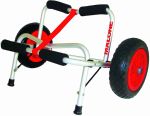 Malone Clipper Deluxe Universal Kayak Cart | Type: Platform Size: 29 x 14 x 7″ Weight: 8.15 lbs. Capacity: 200 lbs. | Amazon |
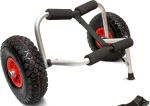 ABN Universal Kayak Carrier | Type: Tail-dragger Size: 22 x 9.2 x 13″ Weight: 7.78 lbs. Capacity: 200 lbs. | Amazon |
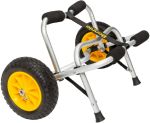 Bonnlo Kayak Cart Canoe Carrier Trolley | Type: Foldable tail-dragger Size: 27 x 12 x 13″ Weight: Unspecified Capacity: 150 lbs. | Amazon |
 Wilderness Systems Heavy Duty Kayak Cart | Type: Platform Size: 32 x 34 x 16″ Weight: 15 lbs. Capacity: 330 lbs. | Amazon |
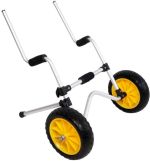 Bonnlo Scupper Kayak Cart | Type: Scupper cart Size: 26 x 24 x 10″ Weight: Unspecified Capacity: 120 lbs. | Amazon |
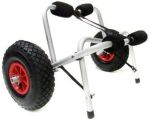 TMS Kayak Carrier Trolley | Type: Tail-dragger Size: 13 x 22 x 9.25″ Weight: 7.78 lbs. Capacity: 150 lbs. | Amazon |
Our 9 Top-Recommended Kayak Carts
Best Overall: RAILBLAZA Ctug Kayak Cart
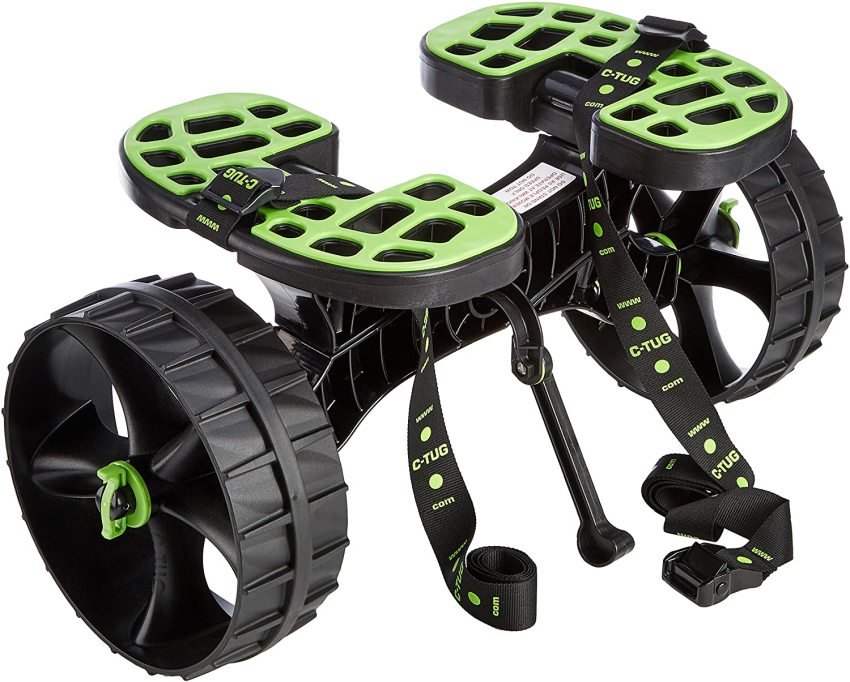
Type: Platform
Material: Reinforced composite, stainless steel, anodized aluminum
Size: 6 x 10 x 30″ (15.24 cm x 25.4 x 76.2 cm)
Weight: 9.6 lbs. (4.35 kg)
Capacity: 300 lbs. (136 kg)
Made in New Zealand, this little platform cart is just what you need to make the kayak-hauling process a breeze. It’s built from all-durable components—a stainless steel and anodized aluminum frame covered with reinforced composite and featuring thermos-bonded elastomeric hull pads that provide excellent cushioning to reduce impact and damage to your kayak.
The solid wheels come with stainless steel reinforced axles that will keep them sturdy and reliable for years of regular use.
But what makes the Railblaza truly our top pick is its easy assembly and disassembly. In literally under a minute, you can put it all together and have it ready to wheel, or dismantle it to store in your kayak’s storage compartments. The rubberized pads are compatible with 99% of kayaks, and the built-in straps are tough and sturdy. There’s even a handy kickstand to keep the cart in position while you load it.
Pros:
- Sturdy, built from reliable components
- Disassembles in seconds for easy storage
- Incredibly easy to load/unload your kayak
- Solid wheels resistant to wear and damage; puncture-free
- Will never rust
Cons:
- Wheels may be too large to fit in smaller kayak storage compartments
- Solid wheels may not be best-suited for rugged terrain or deep sand
Best Weight Capacity: Wilderness Systems Heavy Duty Kayak Cart
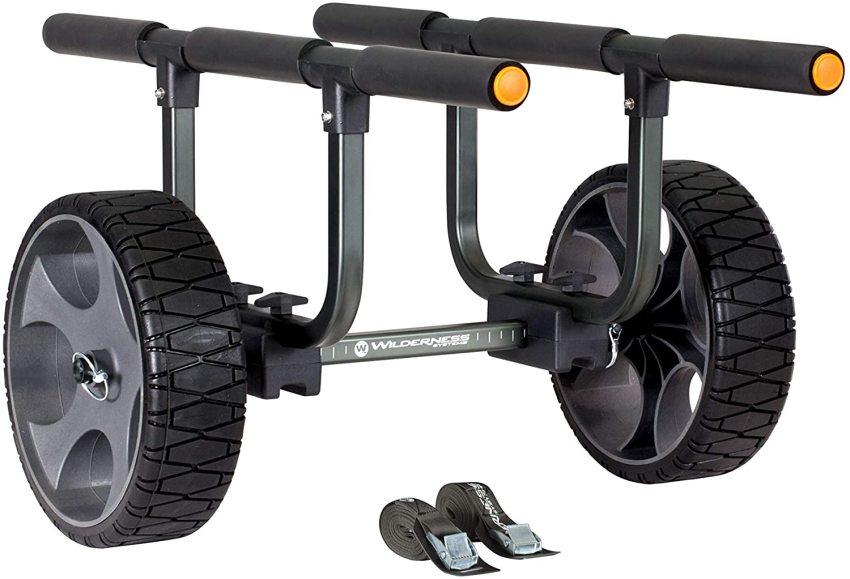
Type: Platform cart
Material: Marine-grade, high-strength, heat-treated aluminum alloy
Size: 33 x 12 x 6.75″ (83.82 x 30.48 x 17.15 cm)
Weight: 13 lbs. (5.9 kg)
Capacity: 450 lbs. (204 kg)
No matter what kind of boat you’ve got to carry—single or tandem kayak, canoe, or john boat—this little cart can handle it. It’s got the highest weight capacity of any kayak cart, a whopping 450 pounds, and the adjustable width ensures that every boat sits securely in place during transportation. There are even two height settings: low height for top-heavy kayaks prone to tipping over, and high height for odd-shaped or extra-deep hulls (preventing rubbing on the wheels).
The solid, no-flat rubber wheels are highly durable, though you’ll need to add extra padding on the transport bars to cushion the impact of rough terrain. It can’t fit into your kayak storage compartments even when broken down, but it’s more than compact enough to tuck in your vehicle trunk or a corner of your garage.
Pros:
- Breaks down quickly into easy-to-store components
- Best-in-class weight capacity
- Adjustable width and height; compatible with all kayak types and sizes
- Highly durable marine-grade aluminum alloy frame
- Compatible with pneumatic tires (sold separately)
Cons:
- Bunker bar frame has minimal padding
- Won’t fit in kayak storage compartment
Best Lightweight: Suspenz Smart Airless DLX Cart
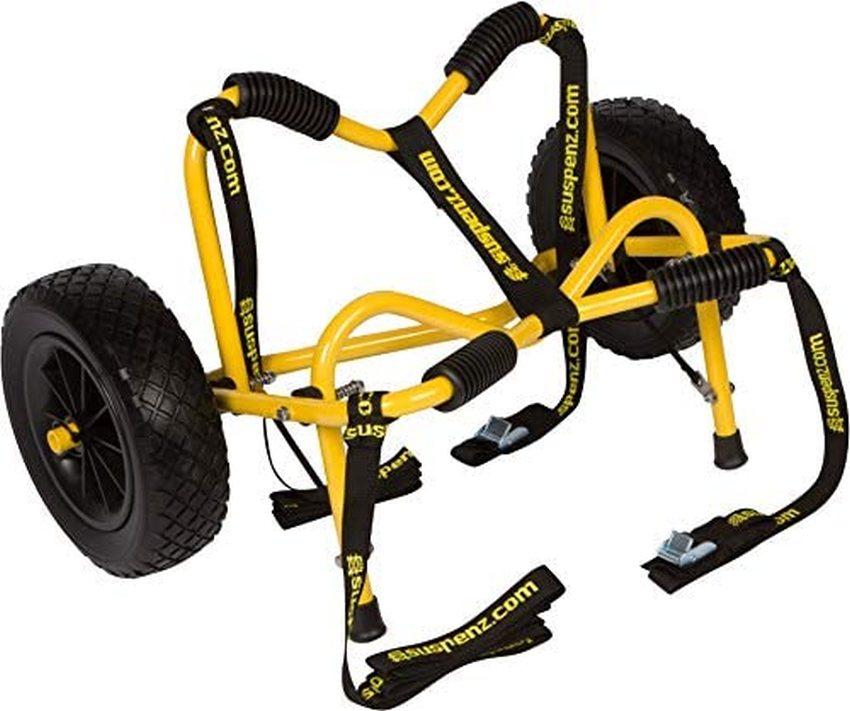
Type: Tail-dragger
Material: Powder-coated aluminum frame, stainless steel hardware
Size: 13 x 18″ (33 x 45.72 cm)
Weight: 9 lbs. (4.08 kg)
Capacity: 125 lbs. (56.7 kg)
Looking for a lightweight cart that makes transporting your kayak a breeze? Give this bad boy a try!
The Suspenz cart weighs under 10 pounds, thanks to its highly durable aluminum frame. The metal has been powder-coated to resist rust, and you’ll find that it’s a solidly-built little cart, though it doesn’t have the greatest weight capacity (just 125 lbs.).
What makes this such a great option is its foldability. Its collapsible design allows you to fold it down small enough to carry around in the provided mesh bag, easy to store in your vehicle (not in your kayak storage compartments).
The 10” solid tires are a bit small, but they roll smoothly even on deep, soft sand. And just to make sure your kayak is safe, the frame comes with rubber pads that will never damage your hull.
Pros:
- Super lightweight; lift it in and out of your vehicle with ease
- Compact, folds down nicely small to tuck out of the way
- Durable and solidly built
- Easy to store in the mesh bag
- Buckles and cinch straps included
Cons:
- Lower-than-average weight capacity
- Not suitable for very uneven or hilly terrain
Most Compatible: Malone Clipper Deluxe Universal Kayak Cart
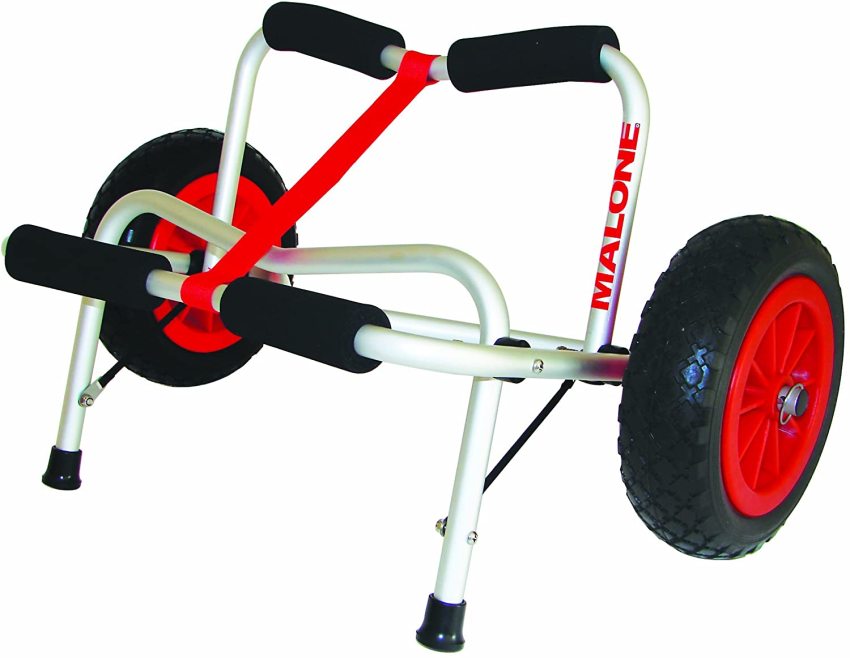
Type: Platform
Material: Anodized aluminum
Size: 29 x 14 x 7″ (73.66 x 35.56 x 17.78 cm)
Weight: 8.15 lbs. (3.62 kg)
Capacity: 200 lbs.(90.71 kg)
No matter what type of kayak (or canoe) you own, this kayak cart by Malone is capable of carrying it. The foldable aluminum frame is designed to be “universal”, meaning it’s wide to accommodate kayaks with literally any hull size or shape.
The frame comes with padding to cushion your kayak’s hull (shielding it from damage), straps to secure it in place, and a stabilizing kickstand that will keep the cart upright while you’re loading. With a 200-pound weight capacity, it’s suitable for any small water vessel you want to take out on the water.
Pros:
- Universal frame compatible with any kayak or canoe
- Compact and lightweight
- Folds down small to fit in your car trunk
- Rugged wheels can handle uneven terrain
- Decent weight capacity
Cons:
- Bigger than other carts (needed to accommodate wider kayaks)
- Performs poorly on very soft sandy terrain
Best Compact: ABN Universal Kayak Carrier
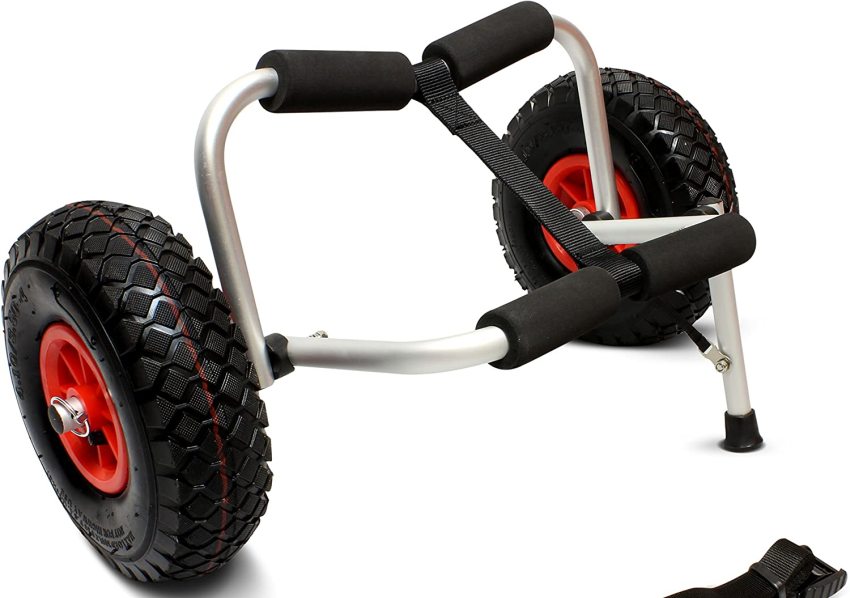
Type: Tail-dragger
Material: Rubber and plastic on anodized steel frame
Size: 22 x 9.2 x 13″ (55.88 x 22.86 x 33 cm)
Weight: 7.78 lbs. (3.52 kg)
Capacity: 200 lbs. (90.7 kg)
Looking for a kayak cart that will fold up very small and fit into your car trunk? This is your best bet! It takes a matter of seconds to pull the lynch pin to remove the wheels, and you can tuck the compact frame into a corner of your vehicle. The pneumatic tires take up a bit more space, but that’s a trade-off well worth it to get better traction on soft and sandy terrain.
The high-strength anodized steel body can handle up to 200 pounds of kayak or canoe, and it’s one of the longest-lasting, most rust-resistant kayak carts on our list. Thanks to the built-in foam bumper pads, you can haul your kayak secure in the knowledge that it will never be dented, dinged, or scratched.
Pros:
- Pneumatic tires provide impact-absorption and better navigation on rough terrain
- Easy to disassemble and store
- Great for broader and deeper kayaks
- Very well-priced
- Durable material and sturdy design
Cons:
- Not totally stable—may tip over on bumpy and uneven terrain
- Straps are short and inefficient (you are better off purchasing your own)
Easiest to Store: Bonnlo Kayak Cart Canoe Carrier Trolley
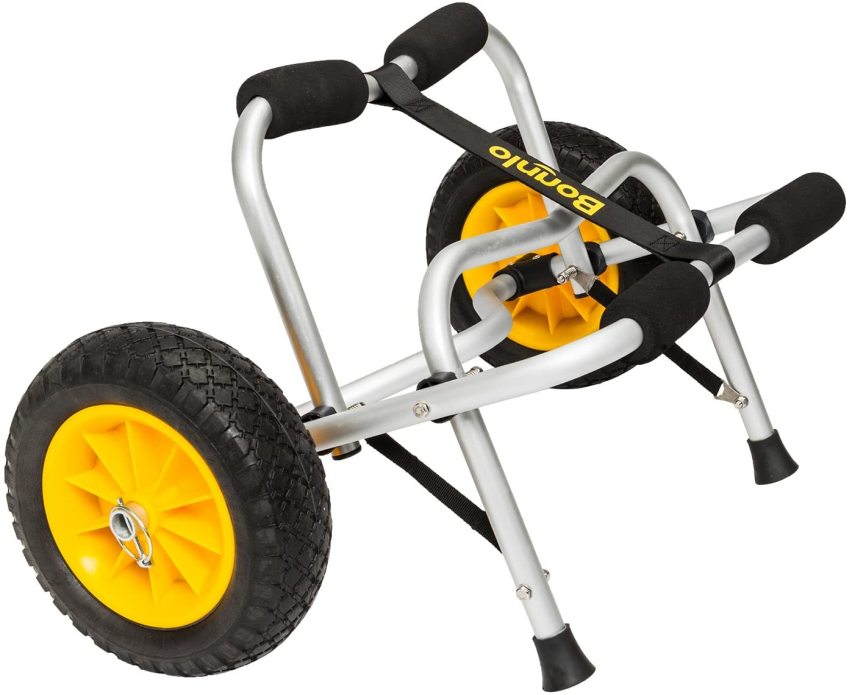
Type: Foldable tail-dragger
Material: High-strength anodized steel
Size: 27 x 12 x 13″ (68.58 x 30.48 x 33 cm)
Weight: Unspecified
Capacity: 150 lbs. (68 kg)
This cart is easy to use to haul your kayak to and from the car, but you’ll love how small it folds down and disassembles for quick storage. Pull the lynch pins to remove the wheels, which can easily be stored in your trunk or a kayak storage compartment. The frame itself is too large to fit in your kayak storage, but you can strap it to the back of your kayak using bungee cords. Its high-strength anodized steel frame will never rust even if you take it paddling with you. There’s even an attached handle to make carrying it a breeze.
Though it doesn’t have the best weight capacity (just 150 pounds), it’s sturdy, solidly built, and stable enough that you’ll love using it.
Pros:
- Easy to fold, disassemble, and store
- Durable and rust-resistant
- Tough, sturdy steel frame
- Compatible with most kayak and canoe sizes
- Comes with 7¾’ ratchet straps
Cons:
- Bolts used to secure the frame MAY be plastic painted to look like metal, and thus less-than-sturdy
- May fold up if you hit a hard bump or rock
Best for Rough Terrain: Wilderness Systems Heavy Duty Kayak Cart
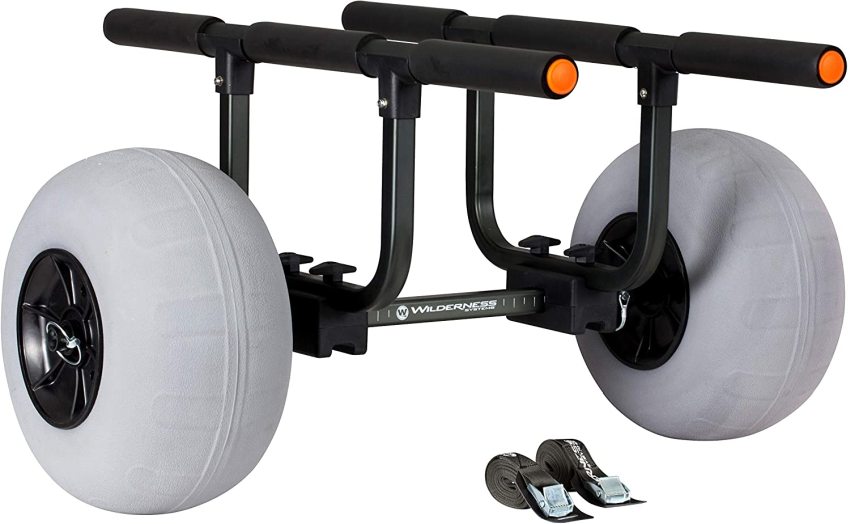
Type: Platform
Material: Marine-grade, high-strength, heat-treated aluminum alloy
Size: 32 x 34 x 16″ (81.28 x 86.36 x 40.64 cm)
Weight: 15 lbs. (6.8 kg)
Capacity: 330 lbs. (149.7 kg)
Taking your kayak over steep sand dunes or through bumpy forest trails to get to your paddling spot? You’re going to want this kayak cart to make transporting your craft a whole lot easier.
This heavy-duty cart comes with a solidly built bunker bar frame secured to an axle featuring balloon-style pneumatic tires. The oversized tires are suited for all terrain—soft sand, hard concrete, dirt trails, scrubby beach grass, you name it! The adjustable-width and adjustable-height frame allows you to adapt the cart to any kayak or canoe to ensure it’s securely cradled and strapped down.
Pros:
- Balloon-style pneumatic tires can navigate any terrain with ease
- Adjustable width and height
- Makes loading and unloading safe and easy
- Straps included
- Super-rugged aluminum alloy frame
Cons:
- Heavy and oversized
- Bunker bar frame comes with minimal padding—you may need to add your own
Best for Sit-On-Top Kayaks: Bonnlo Scupper Kayak Cart
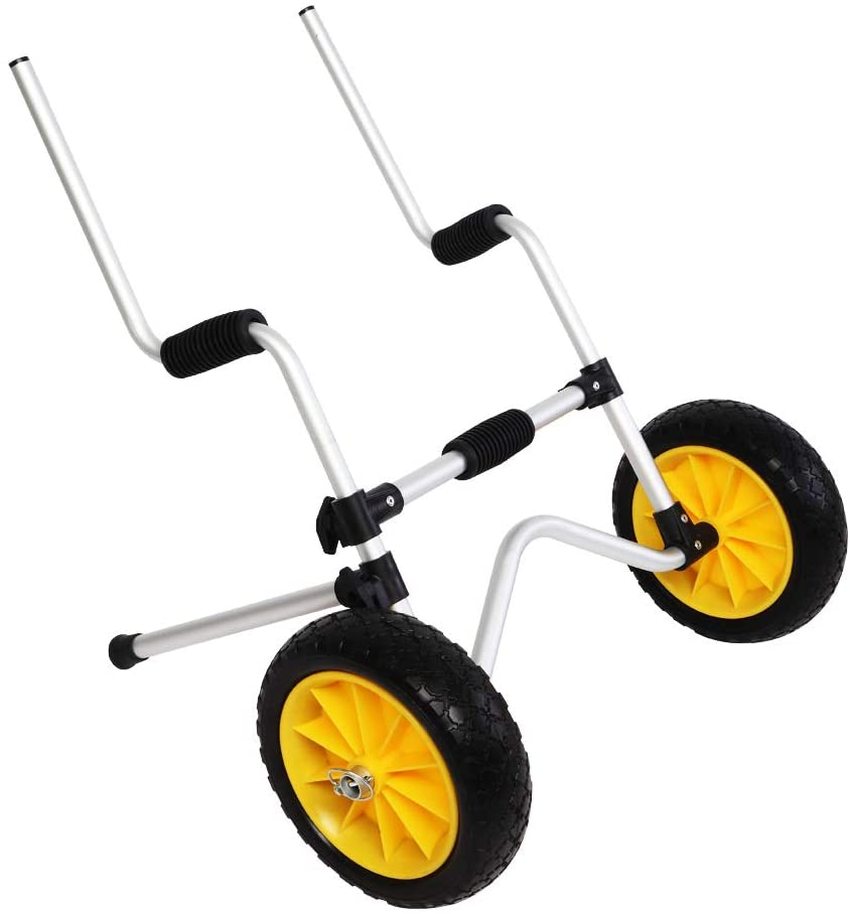
Type: Scupper cart
Material: Aluminum
Size: 26 x 24 x 10″ (66 x 61 x 25.4 cm)
Weight: Unspecified
Capacity: 120 lbs. (54.43 kg)
If you’ve got a sit-on-top kayak with built-in scupper holes, this scupper cart may be your easiest transportation solution. The adjustable frame makes it easy to adapt the cart’s width so you can easily slide the support beams into the scupper holes. You won’t even need to strap it down—gravity will do the work of keeping it securely in place.
The cart is built with a sturdy aluminum frame and rubber cushioning to protect your kayak’s hull, and it’s both foldable and easy to disassemble. It folds down small enough to fit in a backpack or be strapped to the back of your kayak while out on the water, and you’ll never have to worry about it rusting, breaking, or bending.
Pros:
- Sturdy aluminum frame, solidly welded joints
- Simple but highly practice design
- Adjustable width adapts to any sit-on-top kayak
- Compatible with scupper holes ¾” or bigger
- Folds down and disassembles for convenient storage
Cons:
- Wide tires and frame sink into soft sand
- Less-than-stable, may tip over on uneven surfaces
Best Budget: TMS Kayak Carrier Trolley
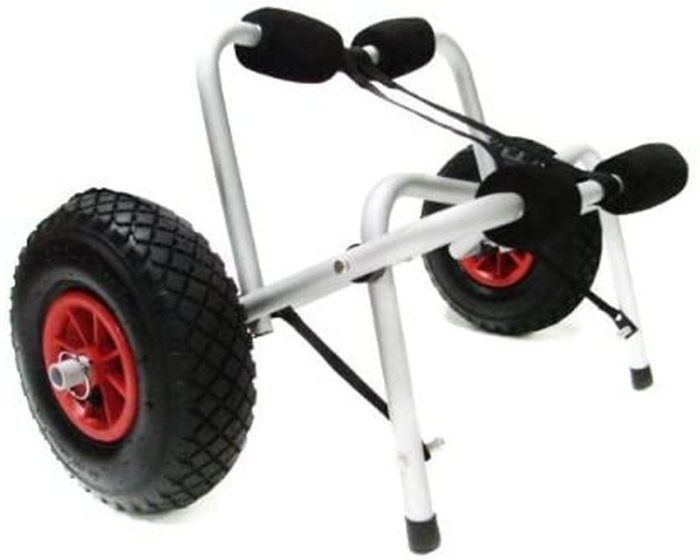
Type: Tail-dragger
Material: Stainless steel and aluminum
Size: 13 x 22 x 9.25″ (33 x 55.88 x 23.5 cm)
Weight: 7.78 lbs. (3.52 kg)
Capacity: 150 lbs (68 kg)
You can’t beat the price tag on this simple yet highly reliable little kayak cart! Built from solid stainless steel and aluminum with foam bumpers to protect your kayak from damage, the cart has a decent weight capacity (150 lbs), a user-friendly design, and a spring-loaded kickstand that makes loading and unloading your kayak incredibly easy.
The cart comes with its own 12-foot tie-down strap, though user reviews indicate that it’s prone to breaking and may need replacement after just a few uses. You’ll love how small it folds down, taking up minimal space in your car trunk or garage when not in use.
Pros:
- Sturdy, stable frame
- Decent weight capacity
- Sized for 99% of kayak and canoe hulls
- Large tires maintain good stability and can handle uneven terrain
- Foldable and compact enough to fit into kayak hatch
Cons:
- Provided straps are less-than-durable (may need to buy your own)
- Struggles with hills
The Ultimate Guide to Kayak Carts
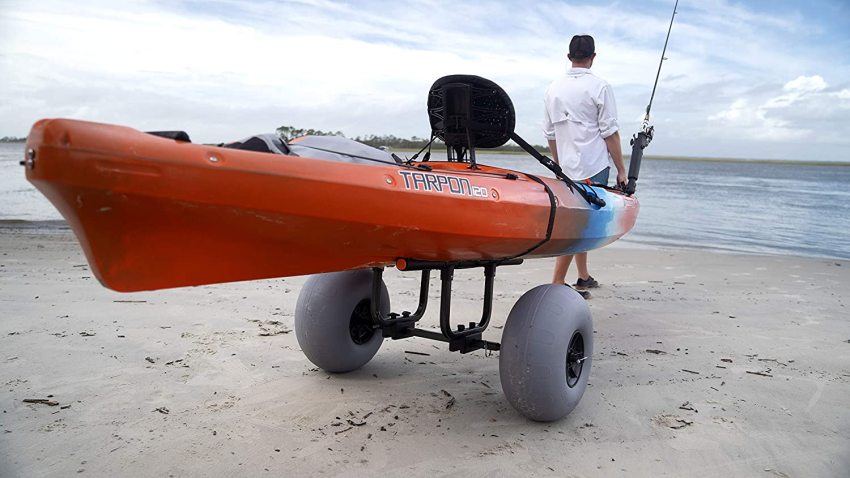
Kayak carts aren’t absolutely necessary on the same level kayak roof racks or storage racks are, but I’ve found they make life a lot easier.
I’m the proud owner of a 14’ Azul Riot, a HEAVY beast of a touring kayak. Even on the best of days, it’s a chore to haul it solo from my car to the water.
But not since I bought a kayak cart! I picked up the Railblaza (which is how I know how awesome it is!) and it made transporting my kayak so much easier. Now even my 5’3” wife can wheel it to the water and back!
So though they’re not a “must-have”, kayak carts really do make the before- and after-paddling process so much easier.
I’ve loved mine since I started using it, so I highly recommend every paddler owns one!
Types of Kayak Carts
When shopping for the best kayak carts, there are three basic types to consider:
Platform Carts
Platform carts are basically an elevated cradle mounted onto a frame with an axle and two wheels. The kayak sits on top of the cradle, you strap it down (straps are typically provided), and you pick up the other end to get hauling. Platform carts are versatile, compatible with most kayak types (fishing and recreational, sit-on and sit-in), and are usually fairly inexpensive.
Tail-dragger Carts
Tail-dragger carts are designed to support the load at one end of the kayak (bow or stern, it’s up to you!). You slide the end of your kayak onto the tail-dragger cart, strap it into place (straps aren’t always provided), and wheel the kayak around easily. They don’t support as much weight as platform carts, which makes them better-suited to short distances. However, they’re typically the cheapest option and are compatible with literally EVERY type of kayak.
Scupper Carts
Scupper carts are an awesomely innovative idea. Basically, the cart has two upright support beams that slide into the scupper holes built into sit-on-top kayaks. They can be used for kayaks without scupper holes (you’ll have to turn the kayak sideways and strap it down), but for sit-on-top kayaks, the beams inserted into the scupper holes are enough to keep the kayak securely on the cart as you wheel it around. However, remember that the width, position, and number of scupper holes will vary from kayak to kayak. The best scupper carts are typically adjustable so they can be widened or narrowed according to the width of the kayak and placement of the holes.
As you can see, each type of kayak cart serves a specific purpose, so choose the cart according to the type of kayak you own.
What Materials Should I Choose?
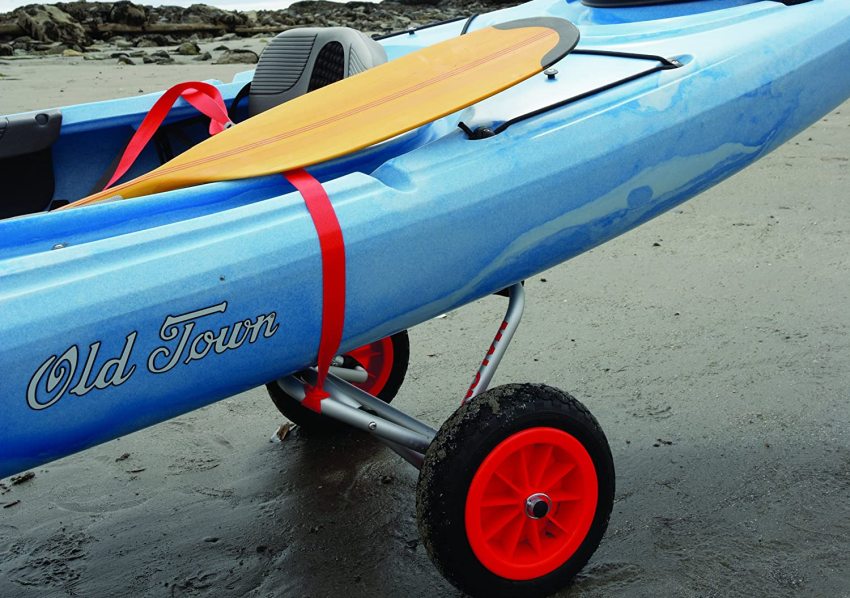
Kayak carts frames are typically made from one of two metals:
Steel
Steel is a tried-and-tested metal that you know won’t break easily, even under the weight of a heavy kayak. Steel does rust, so make sure that it’s finished with a powder coating or rust-resistant paint to maximize its lifespan. Stainless steel is another great option to consider. Steel carts will be both on the pricier and heavier side.
Aluminum
Aluminum is lightweight, rust-resistant, and has great tensile strength, meaning it won’t break under the weight of your kayaks. It’s also typically cheaper than steel. The biggest weaknesses of aluminum frames are typically in the welded joints, but you’ll find that all of the aluminum-frame kayak carts we recommend have a reputation for being made using durable metal welded solidly together.
Some kayaks will feature components made from plastic or carbon composite, but the frame itself (at least on the reliable models we recommend here) will always be metal.
Features to Consider
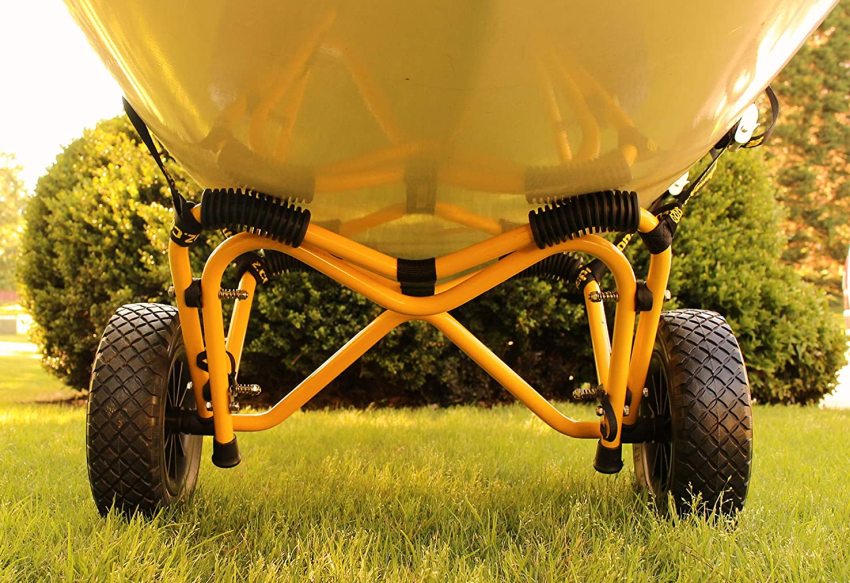
Wheels
Wheels on your kayak carts will either be pneumatic or solid.
Pneumatic (air-filled) rubber tires mounted on metal or plastic rims will usually get better traction, be better-suited to navigating sandy, rough, or uneven terrain (like beaches covered with scrub-grass or forest trails), and give your kayak a less bumpy ride. However, they are pricier, prone to puncture or deflating, and so will often need more maintenance.
Solid wheels can be made from either rubber or plastic, and they typically feature some sort of tread pattern intended to provide good traction on uneven or rough terrain. They offer no impact-absorption like pneumatic tires do, so your kayak will be in for a bumpier ride. However, they are great for wheeling your kayak on solid surfaces (like a parking lot or hard-packed dirt trail) and are both puncture-proof and maintenance-free.
Straps
Scupper carts don’t typically come with straps because they don’t need them. The support beams plugged into the scupper holes will keep the sit-on-top kayak firmly in place. However, if you’re buying a tail-dragger or platform cart, you will need a set of straps to secure your kayak. If the cart doesn’t come with straps included, definitely buy your own.
Adjustable Width
This is a factor to consider if your kayak is extra-wide or extra-deep. Carts are typically made to be “one size fits all”, but for larger/wider/deeper-than-average kayaks, you’ll want a cart that can be adjusted—either the frame itself, or the cradle supporting the kayak.
Weight of Cart
The whole point of a kayak cart is to make the loading/unloading process easier on you. You’ll want a lightweight, easily maneuverable cart that takes minimal effort to load and unload from your vehicle.
Weight Capacity
This is a factor to consider according to the size and weight of your kayak. Most kayak carts have a weight capacity of upwards of 100 lbs., more than enough for even the heaviest kayaks. However, it’s always good to look at kayak carts with a higher weight capacity just to make sure it can handle the weight of bigger boats (such as tandem kayaks and canoes)—PLUS all your gear.
Storage
In a perfect world, you’d want a kayak cart that can be folded down small to fit in one of the kayak’s built-in storage compartments, or which doesn’t take up too much space in the back of your vehicle when not in use. If the foldable options don’t serve your needs, make sure to find a kayak cart that you’re certain will fit in your vehicle’s trunk or luggage space.
RELATED: 9 Best Kayak Racks for Trucks (2023 Buyer’s Guide)
Bumper Pads
This is a very handy feature to consider on a kayak cart! Rubber or foam pads can provide cushioning and reduce impact on your kayak, which is vital for protecting it from scratches, dents, and hull damage during transportation.
FAQs
It all depends on how far you park from the water. If, for example, you can pull right up to the boat launch or dock and unload your kayaks directly into the water, then you have no need for a kayak cart. But if the parking lot is a few hundred yards (or more!) from the water’s edge, then it’s definitely worth the expense to buy a kayak cart. It just makes it so much easier to haul the vessel right to the water with half the effort.
Anyone who doesn’t want to haul the kayak over their head! Solo carrying isn’t too difficult if you’re hauling a smaller, lighter kayak, but you may still struggle with the weight and balance. And if you’re trying to haul a heavier, bigger kayak to the water, it can be too much for one person to handle alone—without a cart, that is. If you’re the one doing most of the heavy lifting, it may be worth getting a kayak cart just to make the loading/unloading process easier.
You have three basic options: 1) stow it in your vehicle, 2) strap it to the back of your kayak with bungee cord (built-in or purchased separately), or 3) if it’s foldable or disassembles small enough, slide it into the hatch of your sit-in kayak.
Absolutely! In fact, using a kayak cart, it’s actually easier to slide the kayak onto your roof rack without ever having to put it on hard ground, concrete, mud, or grass. Just wheel the kayak up behind the car, elevate the end you’re carrying, and lift that end onto the rack. Then unstrap the kayak from the cart and slide it right up into place. Quick and easy!







